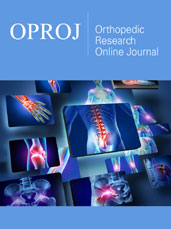- Submissions

Abstract
Orthopedic Research Online Journal
Myofascial and Articular Treatment of Adolescent Idiopathic Scoliosis (AIS)
-
Open or CloseLucy Whyte Ferguson1*, Orrin B Myers2, Matthew A Barela3 and Selina R Silva4
1Department of Neurosurgery, University of New Mexico School of Medicine, University of New Mexico, USA
2Department of Family and Community Medicine, University of New Mexico School of Medicine, University of New Mexico, USA
3Department of Emergency Medicine, University of New Mexico School of Medicine, University of New Mexico, USA
4Orthopaedic Residency Program, Carrie Tingley Childrens’ Hospital, University of New Mexico School of Medicine, USA
*Corresponding author:Lucy Whyte Ferguson, Department of Neurosurgery, University of New Mexico School of Medicine, University of New Mexico, USA
Submission: July 26, 2024;Published: August 15, 2024

ISSN : 2576-8875Volume11 Issue2
Abstract
Background: In addition to brace usage, a consensus is emerging that individualized exercise focusing on addressing muscle imbalances, thereby decreasing asymmetrical loading of the spine, can improve outcomes of scoliosis care and reduce need for corrective surgery [1-4]. There has not, however, been exploration of treating asymmetrical tensions on the spine due to myofascial dysfunction and fascial constriction.
Purpose: This study was designed to develop individualized treatment based on fascial science to reduce rate of scoliosis progression and/or reduce degree of curvature and possibly reduce need for corrective surgery.
Study Design: This is a Randomly Controlled Trial (RCT) of subjects with (AIS), randomly assigned to a Control Group (CG) and an Active Treatment Group (ATG). CG subjects received standard care. ATG subjects received myofascial and articular treatment 2x/month for 6 months, with individualized home exercise. Subjects in both groups who had been prescribed braces continued bracing throughout participation.
Study selection criteria: age 10-15 years, curvature of 15 to 30°, no other disorder responsible for spinal curvature, bone growth not completed. Measurements were performed at the beginning and after 6 months of participation, at a university children’s hospital to assess results in the CG and the ATG. Self-reported Measurements: subjects filled out visual analog pain questionnaire and quality-of-life questionnaire: SRS 22. Physiologic Measurements: X-rays (Cobb angle measurements); scoliometer measurements of degree of rib prominence.
Results: The COVID pandemic affected recruitment of subjects: 9 in the CG, 10 in the ATG. When 2 crossover subjects were added to the ATG there were 2 statistically significant differences: rating of pain; SRS-22 questionnaire responses. There were unusual decreases of spinal curvatures in 40% of ATG subjects: -13° in 2 subjects, -10° in 1 subject, -9° in 1 subject. Only 1 subject in the CG experienced a significant decrease of spinal curvature: -7°.
Conclusion: It would not have been possible to produce these decreases of scoliotic curvatures if structural changes in the spine (collapse) accounted for the development of scoliotic curvatures. Furthermore, the study allowed for systematic clinical observations that shed light on the etiology of AIS and may inform future treatment to reduce or reverse progression of AIS.
Keywords:Adolescent idiopathic scoliosis; Myofascial dysfunction; Fascial dysfunction; Muscle imbalance; Ligamentous laxity; Imbalance of pelvis; Biotensegrity; Over-pronation
 a Creative Commons Attribution 4.0 International License. Based on a work at www.crimsonpublishers.com.
Best viewed in
a Creative Commons Attribution 4.0 International License. Based on a work at www.crimsonpublishers.com.
Best viewed in 







.jpg)






























 Editorial Board Registrations
Editorial Board Registrations Submit your Article
Submit your Article Refer a Friend
Refer a Friend Advertise With Us
Advertise With Us
.jpg)






.jpg)














.bmp)
.jpg)
.png)
.jpg)










.jpg)






.png)

.png)



.png)






